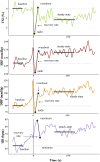Increased multimorbidity is associated with impaired cerebral and peripheral hemodynamic stabilization during active standing
- PMID: 35535653
- PMCID: PMC9545463
- DOI: 10.1111/jgs.17810
Increased multimorbidity is associated with impaired cerebral and peripheral hemodynamic stabilization during active standing
Abstract
Background: Age-related morbidities and frailty are associated with impaired blood pressure (BP) and heart rate (HR) recovery after standing. Here we investigate how multimorbidity affects cerebral and peripheral hemodynamics during standing in a large sample of older patients.
Methods: Patients were recruited from a national Falls and Syncope Unit. They underwent an active stand test (5-10 min lying +3 min standing) with monitoring of continuous BP, HR, total peripheral resistance (TPR), stroke volume (SV), and a near-infrared spectroscopy (NIRS) derived cerebral tissue saturation index (TSI). A multimorbidity count was derived from a 26-item list of conditions. Features derived from the signals included: nadir, overshoot, value at 30 s, steady-state and recovery rate. Robust linear regression was used to assess the association between multimorbidity, TSI and peripheral hemodynamics while correcting for covariates. A p-value <0.05 was considered statistically significant.
Results: Multimorbidity was associated with poorer recovery of TSI at 30 s after standing (β: -0.15, CI:[-0.25-0.06], p = 0.009) independent of all peripheral hemodynamics. Impaired diastolic BP (DBP) recovery at 30s (β:-1.34, CI:[-2.29-0.40], p = 0.032), DBP steady-state (β:-1.18, CI:[-2.04-0.32], p = 0.032), TPR overshoot-to-nadir difference (β:-0.041, CI:[-0.070-0.013], p = 0.045), and SV at 30s (β:1.30, CI:[0.45 2.15], p = 0.027) were also associated with increasing multimorbidity. After sex stratification, only females demonstrated impaired TSI with multimorbidity at overshoot (β: -0.19, CI: [-0.32 -0.07], p = 0.009), 30 s (β: -0.22 [-0.35-0.10], p = 0.005) and steady-state (β: -0.20, CI:[-0.35-0.04], p = 0.023), independent of peripheral hemodynamics.
Conclusions: Transient cerebral oxygenation and peripheral hemodynamic responses are impaired with multimorbidity (frailty) in older patients, particularly in females. This study demonstrates the feasibility of using NIRS in this clinical context and may inform the development of clinical management strategies targeting both cerebral oxygenation and blood pressure impairments in patients with faints and falls.
Keywords: active standing; cerebral oxygenation; multimorbidity; near-infrared spectroscopy; orthostatic hypotension.
© 2022 The Authors. Journal of the American Geriatrics Society published by Wiley Periodicals LLC on behalf of The American Geriatrics Society.
Conflict of interest statement
The authors have no conflicts of interest to disclose.
Figures



Similar articles
-
Cerebral Oxygenation Responses to Standing in Young Patients with Vasovagal Syncope.J Clin Med. 2023 Jun 21;12(13):4202. doi: 10.3390/jcm12134202. J Clin Med. 2023. PMID: 37445237 Free PMC article.
-
Age and sex related differences in orthostatic cerebral oxygenation: Findings from 2764 older adults in the Irish Longitudinal Study on Ageing (TILDA).Exp Gerontol. 2022 Oct 1;167:111903. doi: 10.1016/j.exger.2022.111903. Epub 2022 Jul 25. Exp Gerontol. 2022. PMID: 35902001
-
Impairments in Hemodynamic Responses to Orthostasis Associated with Frailty: Results from The Irish Longitudinal Study on Ageing (TILDA).J Am Geriatr Soc. 2018 Aug;66(8):1475-1483. doi: 10.1111/jgs.15327. Epub 2018 Apr 18. J Am Geriatr Soc. 2018. PMID: 29668044
-
Cardiovascular regulation during active standing orthostatic stress in older adults living with frailty: a systematic review.Arch Gerontol Geriatr. 2025 Sep;136:105894. doi: 10.1016/j.archger.2025.105894. Epub 2025 May 16. Arch Gerontol Geriatr. 2025. PMID: 40411932
-
Determinants of orthostatic cerebral oxygenation assessed using near-infrared spectroscopy.Auton Neurosci. 2022 Mar;238:102942. doi: 10.1016/j.autneu.2022.102942. Epub 2022 Jan 20. Auton Neurosci. 2022. PMID: 35124323 Review.
Cited by
-
The Impact of Type 2 Diabetes on Peripheral and Cerebral Hemodynamic Responses to Active Stand.J Gerontol A Biol Sci Med Sci. 2024 May 1;79(5):glae073. doi: 10.1093/gerona/glae073. J Gerontol A Biol Sci Med Sci. 2024. PMID: 38436476 Free PMC article.
-
Prospective association of occupational and leisure-time physical activity with orthostatic blood pressure changes in older adults.Sci Rep. 2023 Nov 24;13(1):20704. doi: 10.1038/s41598-023-46947-7. Sci Rep. 2023. PMID: 38001151 Free PMC article.
-
Cerebral Oxygenation Responses to Standing in Young Patients with Vasovagal Syncope.J Clin Med. 2023 Jun 21;12(13):4202. doi: 10.3390/jcm12134202. J Clin Med. 2023. PMID: 37445237 Free PMC article.
-
Preoperative physical resilience indicators and their associations with postoperative outcomes.Geroscience. 2025 Jun;47(3):4857-4870. doi: 10.1007/s11357-025-01633-6. Epub 2025 Apr 2. Geroscience. 2025. PMID: 40175848 Free PMC article.
-
Review of Blood Pressure Control in Vulnerable Older Adults: The Role of Frailty and Sarcopenia.J Vasc Dis. 2025 Jun;4(2):18. doi: 10.3390/jvd4020018. Epub 2025 May 14. J Vasc Dis. 2025. PMID: 40697250 Free PMC article.
References
-
- McNicholas T, Tobin K, Carey D, O'Callaghan S, Kenny RA. Is baseline orthostatic hypotension associated with a decline in global cognitive performance at 4‐year follow‐up? Data from TILDA (the Irish longitudinal study on ageing). J Am Heart Assoc. 2018;7(19):e008976. doi:10.1161/JAHA.118.008976 - DOI - PMC - PubMed
Publication types
MeSH terms
Grants and funding
LinkOut - more resources
Full Text Sources

